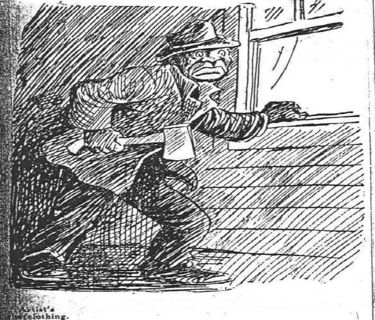Henry the Hacker: Difference between revisions
(Redirected page to Axe syndicate) |
No edit summary |
||
| Line 1: | Line 1: | ||
[[File:Henry the Hacker.jpg|right|thumb|375px|The ''Age-Herald'' 1922 depiction of "Henry the Hacker".]] | |||
'''Henry the Hacker''' was a fictional personality created by the ''[[Birmingham Age-Herald]]'' to personify the villain believed to be responsible for a [[Axe syndicate|series of murders]] across the city. A cartoon illustration of a black male approaching a window and holding an axe was published in the paper's [[January 27]], [[1922]] edition. | |||
By [[1923]] [[Birmingham Police Department|Birmingham Police Chief]] [[Fred McDuff]] proclaimed that, "the creature viewed as one individual is a figment of the imagination." The crimes were apparently the work of more than one attacker, possibly initiated by a single [[Axe syndicate|gang]] and then spread by copycats. Two contemporary patterns of violent attacks, a series of brutal robberies of shopkeepers and another string of attacks against white men seen in the company of black women, were presumed to be linked. | |||
Though a few African American members of a supposed murder gang were successfully prosecuted, and the spree appeared to end in the Spring of [[1924]], some victims' family members blamed the Italian mafia for a violent campaign of intimidation and extortion that was eventually eradicated by local vigilantes rather than law enforcement agencies. | |||
[[Category:Cartoons]] | |||
[[Category:1922 works]] | |||
Latest revision as of 11:53, 21 December 2015
Henry the Hacker was a fictional personality created by the Birmingham Age-Herald to personify the villain believed to be responsible for a series of murders across the city. A cartoon illustration of a black male approaching a window and holding an axe was published in the paper's January 27, 1922 edition.
By 1923 Birmingham Police Chief Fred McDuff proclaimed that, "the creature viewed as one individual is a figment of the imagination." The crimes were apparently the work of more than one attacker, possibly initiated by a single gang and then spread by copycats. Two contemporary patterns of violent attacks, a series of brutal robberies of shopkeepers and another string of attacks against white men seen in the company of black women, were presumed to be linked.
Though a few African American members of a supposed murder gang were successfully prosecuted, and the spree appeared to end in the Spring of 1924, some victims' family members blamed the Italian mafia for a violent campaign of intimidation and extortion that was eventually eradicated by local vigilantes rather than law enforcement agencies.
